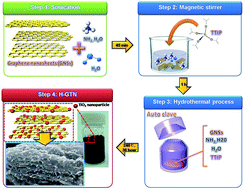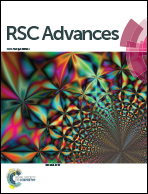Hydrothermal synthesis of a uniformly dispersed hybrid graphene–TiO2 nanostructure for optical and enhanced electrochemical applications
Abstract
Highly dispersed TiO2 nanoparticles on graphene nanosheets were achieved by hydrothermal treatment of graphene nanosheets obtained by modified Hummer's method followed by thermal exfoliation. The hybrid graphene TiO2 nanostructure composite (H-GTN) showed enhanced optical and electrochemical properties for future application as a supercapacitor. The structural, optical and electrochemical properties of the composite are systematically investigated. The as-prepared H-GTN showed a quenching phenomenon of its photoluminescence properties, which was attributed to the specific properties of graphene. Remarkably, the CV test obtained for H-GTN showed a very high specific capacitance value up to 530 F g−1 at a scan rate of 3 mV s−1, and nearly stable capacitance of 400 F g−1 above 20 mV s−1. The cyclic stability test shows stable behavior after some initial cycles and the stability was then retained without obvious aging or performance degradation, showing long cyclic stability. This is attributed to the excellent electrochemical performance of the H-GTN electrode material for practical application in energy storage devices.


 Please wait while we load your content...
Please wait while we load your content...